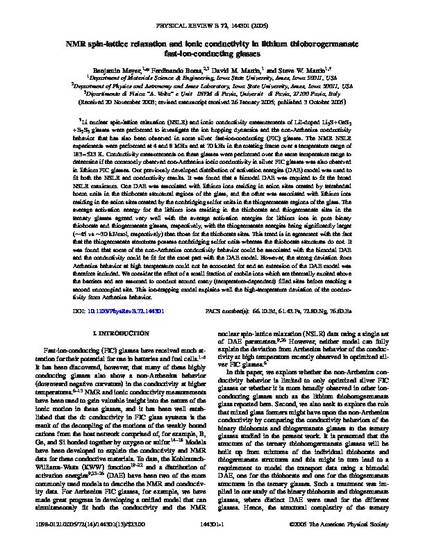
Li7 nuclear spin-lattice relaxation (NSLR) and ionic conductivity measurements of LiI-doped Li2S+GeS2+B2S3 glasses were performed to investigate the ion hopping dynamics and the non-Arrhenius conductivity behavior that has also been observed in some silver fast-ion-conducting (FIC) glasses. The NMR NSLR experiments were performed at 4 and 8MHz and at 70kHz in the rotating frame over a temperature range of 183–523K. Conductivity measurements on these glasses were performed over the same temperature range to determine if the commonly observed non-Arrhenius ionic conductivity in silver FIC glasses was also observed in lithium FIC glasses. Our previously developed distribution of activation energies (DAE) model was used to fit both the NSLR and conductivity results. It was found that a bimodel DAE was required to fit the broad NSLR maximum. One DAE was associated with lithium ions residing in anion sites created by tetrahedral boron units in the thioborate structural regions of the glass, and the other was associated with lithium ions residing in the anion sites created by the nonbridging sulfur units in the thiogermanate regions of the glass. The average activation energy for the lithium ions residing in the thioborate and thiogermanate sites in the ternary glasses agreed very well with the average activation energies for lithium ions in pure binary thioborate and thiogermanate glasses, respectively, with the thiogermanate energies being significantly larger (∼45 vs ∼30kJ/mol, respectively) than those for the thioborate sites. This trend is in agreement with the fact that the thiogermanate structures possess nonbridging sulfur units whereas the thioborate structures do not. It was found that some of the non-Arrhenius conductivity behavior could be associated with the bimodal DAE and the conductivity could be fit for the most part with the DAE model. However, the strong deviation from Arrhenius behavior at high temperature could not be accounted for and an extension of the DAE model was therefore included. We consider the effect of a small fraction of mobile ions which are thermally excited above the barriers and are assumed to conduct around many (temperature-dependent) filled sites before reaching a second unoccupied site. This ion-trapping model explains well the high-temperature deviation of the conductivity from Arrhenius behavior.
Available at: http://works.bepress.com/steve_martin/22/

This article is from Physical Review B 72 (2005): 144301, doi:10.1103/PhysRevB.72.144301.